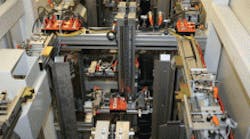Resources Distech Sytems Inc., (585) 254-7020, distechsystems.com ifm efector Inc., (800) 441-8246, ifm.com/us |
A firm that makes machine-tool loading equipment for manufacturing cells used an inexpensive open network to replace a lot of hardwiring on the I/O running its modular machines.
Loading equipment from Distech Systems Inc. in Rochester, N.Y., typically includes an automated mechanism that accepts stacks of trays from carts. An elevator transfers the top tray in the stack. A robotic arm empties or fills the tray, and the completed tray then moves to a restack station.
Previous generations of the machine were hardwired. Each discrete input — hundreds of them — required a cable that snaked back to the junction block and the control panel. This strategy was expensive and space consuming. Connections to the articulating robot were difficult as well. Robot makers provide only a limited number of conductors to control end-of-arm (EOA) tooling, problematic because Distech offers many options of EOA.
An Actuator-Sensor interface (AS-i) bus now takes the place of hardwiring. AS-i is a low-level, inexpensive, open network for sensors and simple actuators. It was devised in 1990 by a nonprofit consortium consisting mainly of sensor manufacturers and is now supported by more than 100 vendors worldwide. Inside the tray loader, proximity sensors from ifm effector, Exton, Pa., locate pneumatic slides, monitor elevator lifts, detect trays, and monitor inputs.
A basic AS-i structure consists four main components: a controller, power supply, standard I/O modules, and a trapezoidal “flat” cable that carries power and data to a controller. To set up a system, the cable is positioned along the I/O point’s path. The I/Os connect to the cable using AS-i snap-and-go piercing devices. One cable can connect a whole network of I/O points. If needed, a user can also add splitter modules to branch and lengthen the network. The controller handles all communication over the AS-i cable. The power supply feeds a symmetrical supply voltage into the cable which provides communication and powers the sensors.
Numerous companies offer AS-i networking, but each has its own style of connection components such as controllers, power supplies, and modules. Distech eventually used the AS-i approach from ifm efector, a founding member of the AS-i consortium. One reason: ifm I/O field modules are smaller than most and fit easily inside Distech’s tool loader. A quick-mount slide lets the flat cable sandwich between the upper module and its base without any mounting screws. And the width of the AS-i block mates perfectly to the Bosch rail used throughout the machines.
The AS-i network is not limited by topology and structure, so there are no restrictions on adding or removing components — Distech engineers can snap in a block or clip on a splitter where needed. The AS-i spec also lets users transition from a flat cable at the block, to a high-flex round cable, and back to a flat cable wherever needed, without restrictions.
An ifm Controller-E PLC/gateway lets up to 868 AS-i I/O points appear as one node on a higher-level Ethernet IP system. Auto-addressing features of the AS-i network let a new block program itself when taking the place of a bad one.
The AS-i network has simplified connections to the point where mechanics rather than electricians lay out I/O and wire the machine.
